List of content you will read in this article:
Forex trading is one of the most active and accessible financial markets in the contemporary world. It runs all day, five days a week. The forex market is a great opportunity for dealers across the continent, but it is the opposite of simplicity. So, a dealer must be armed with a clear forex trading strategy to succeed.
In this guide for 2025, we're diving into the 10 Best Forex Trading Strategies. Let's delve into forex trading strategies for beginners that will guide beginners and pros alike, motivating you on your goal and what you want to achieve.
What is a Forex Trading Strategy?
A forex trading strategy consists of ideas that are outlined in steps by the trader on whether or not to buy or sell currency pairs in the foreign exchange market and broker. Trading strategies combine various tools and techniques such as technical indicators, fundamental analysis, and rules to manage risk to help traders make informed decisions while minimizing emotional bias.
The strategies are generally directed toward executing high probability trades that might suit the trader's objective, risk profiles, and market conditions. Profitable Forex Strategies offer a blueprint for consistent and disciplined trading, whether you trade to gain short-term or long-term gains.
Related Article: What is a forex VPS?
The 10 Best Forex Trading Strategies
In the vast and intricate landscape of forex trading, traders have developed a multitude of strategies over the years. Each strategy has its unique characteristics, making it suitable for different market conditions and trading preferences. Let's delve into the ten best forex trading strategies, providing examples to illustrate their concepts.
Related Article: Secure Forex Trading, Definition and Best Practices
Scalping Strategy
Scalpers aim to profit from small price movements within short timeframes, often executing dozens or even hundreds of trades in a single day. They might enter a trade when they see a currency pair's price moving just a few pips and exit as soon as they make a small profit.
- Type: High-frequency, short-term
- Best For: Quick profits in liquid markets
- Difficulty: Advanced
- Strategy Style: Momentum-based, technical
- Best Indicators: RSI, Moving Averages, MACD
Pros:
- Quick returns
- Lots of trade opportunities
Cons:
- Stressful
- Requires high discipline and tools
Day Trading Strategy Forex
Day traders open and close positions within the same trading day. They rely on technical analysis and market indicators to identify intraday trends and capitalize on price fluctuations. For instance, a day trader might buy a currency pair in the morning and sell it in the afternoon, seeking to profit from the day's volatility.
- Type: Intraday
- Best For: Traders with daily availability
- Difficulty: Intermediate
- Strategy Style: Momentum and trend-based
- Best Indicators: Bollinger Bands, RSI, Moving Averages
Pros:
- No overnight risk
- Capitalizes on daily news
Cons:
- Time-intensive
- Emotionally draining
Swing Trading Strategy
Swing traders aim to capture medium-term price movements by holding positions for several days to weeks. They analyze both technical and fundamental factors to identify potential trends. For instance, a swing trader might enter a trade based on a currency pair's strong uptrend and exit when signs of a reversal appear.
- Type: Medium-term
- Best For: Traders who can hold positions for days
- Difficulty: Beginner to Intermediate
- Strategy Style: Trend and pattern-based
- Best Indicators: Fibonacci, MACD, RSI
Pros:
- Less screen time
- Higher reward potential per trade
Cons:
- Exposure to overnight risk
- Requires patience
Trend-Following Strategy
Trend followers focus on identifying and trading in the direction of dominant market trends. They use indicators like moving averages to confirm trends and enter trades accordingly. For example, if a currency pair has been in a strong uptrend, a trend follower would buy when the price retraces to a moving average support level.
- Type: Long-term
- Best For: Capitalizing on strong trends
- Difficulty: Beginner
- Strategy Style: Trend-based
- Best Indicators: Moving Averages, ADX, Trendlines
Pros:
- Simple and effective
- Great for beginners
Cons:
- Late entries possible
- Not ideal in choppy markets
Range Trading Strategy
Range traders seek to profit from currency pairs that trade within specific price ranges. They identify levels of support and resistance and execute buy orders near support and sell orders near resistance. For instance, if a currency pair consistently bounces between $1.10 and $1.12, a range trader would buy at $1.10 and sell at $1.12.
- Type: Mean-reversion
- Best For: Sideways markets
- Difficulty: Beginner
- Strategy Style: Support/resistance-based
- Best Indicators: RSI, Stochastic, Bollinger Bands
Pros:
- Easy to implement
- Low risk when properly managed
Cons:
- Breakouts can cause losses
- Requires close-range analysis
Breakout Strategy Forex
Breakout traders look for significant price movements that breach key support or resistance levels. When a breakout occurs, they enter positions in the direction of the breakout. For example, if a currency pair breaks above a strong resistance level at $1.20, a breakout trader would go long, expecting further upward momentum.
- Type: Breakout/momentum
- Best For: Volatile markets
- Difficulty: Intermediate
- Strategy Style: Price action and volume-based
- Best Indicators: Volume, MACD, Donchian Channel
Pros:
- Profits from volatility
- High potential reward
Cons:
- False breakouts are common
- Requires confirmation tools
Counter-Trend Trading Strategy
Counter-trend traders go against the prevailing market sentiment. They aim to profit from reversals by identifying overbought or oversold conditions in the market. For instance, if a currency pair has been in a prolonged downtrend and shows signs of exhaustion, a counter-trend trader might enter a long position, anticipating a reversal.
- Type: Mean-reversion
- Best For: Experienced traders spotting reversals
- Difficulty: Advanced
- Strategy Style: Reversal-based
- Best Indicators: RSI, Divergence, Candlestick Patterns
Pros:
- High reward when reversal occurs
- Contrarian edge
Cons:
- Risky if the trend continues
- Needs precision timing
Carry Trade Strategy
Carry traders focus on interest rate differentials between two currencies. They borrow funds in a currency with a low interest rate and invest in a currency with a higher interest rate. They earn the interest rate differential as profit. For example, a carry trader might borrow Japanese yen at a low interest rate and invest in Australian dollars with a higher interest rate.
- Type: Long-term interest-based
- Best For: Passive investors
- Difficulty: Intermediate
- Strategy Style: Fundamental-based
Pros:
- Passive income
- Long-term potential
Cons:
- Vulnerable to currency volatility
- Requires macroeconomic knowledge
Hedging Strategy
Hedgers use forex to mitigate risk in other investments. For instance, a company with international operations might use hedging to protect against adverse currency movements. If they expect their home currency to weaken, they might enter a forex position that benefits from that weakness, offsetting potential losses in other areas of their business.
- Type: Risk mitigation
- Best For: Protecting other investments
- Difficulty: Intermediate
- Strategy Style: Risk-based
Pros:
- Reduces risk
- Strategic risk planning
Cons:
- Low profitability
- Complex to manage
Algorithmic Trading Strategy
Algorithmic traders use computer algorithms to execute trades automatically based on predefined criteria. These criteria can include technical indicators, price patterns, or news sentiment. Algorithmic trading is prevalent in today's markets, with sophisticated algorithms making split-second decisions.
- Type: Automated
- Best For: Tech-savvy traders
- Difficulty: Advanced
- Strategy Style: Programmatic trading
- Best Indicators: Custom-coded scripts, AI-based analysis
Pros:
- 24/7 trading
- Emotionless execution
Cons:
- Requires programming knowledge
- Needs constant optimization

How to Choose the Right Forex Trading Strategy?
Selecting a Forex trading strategy is key to your success in the long term, especially in a dynamic market such as 2025. The perfect strategy should match your trading goals, risk tolerance, time commitment, and level of experience.
In knowing that your profile fits the characteristics of the strategy, you maximize your chances of achieving a consistent performance and avoid costly emotional mistakes. Here is how to evaluate what works best for you:
- Trading Goals and Objectives: Define whether you’re trading for quick gains or long-term growth. Short-term traders may prefer scalping or day trading, while long-term investors may find swing or trend-following strategies more suitable.
- Risk Tolerance: Understand how much loss you can emotionally and financially handle. Conservative traders may benefit from range or carry strategies, while risk-tolerant traders might explore breakout or counter-trend strategies.
- Time Availability: Assess how much time you can dedicate to trading each day. If you can monitor markets regularly, intraday strategies work well; if not, go for longer-term approaches like swing trading.
- Experience and Skill Level: Beginners should start with simpler strategies like trend-following or range trading. More experienced traders can handle complex strategies like algorithmic trading or scalping.
- Market Conditions: Choose a strategy based on the current market environment—trending, ranging, or volatile. For example, breakout strategies work best in high-volatility periods, while range strategies suit sideways markets.
- Psychological Resilience: Some strategies require more emotional discipline than others. If you're prone to stress, avoid high-frequency styles like scalping and consider structured systems like algorithmic trading.
- Backtesting and Demo Testing: Always test your strategy using historical data and demo accounts before trading real money. This helps validate the approach and builds confidence without risking your capital.
- Technology and Tools: Evaluate whether you have access to the tools required for your strategy. For example, scalpers may need a fast Forex VPS, while algo traders need reliable coding platforms and automation.
Conclusions
The Forex market in 2025 has unprecedented tools, access, and flexibility available to the trader, but success relies on an effective strategy. It is paramount to use a trading style that suits individual characteristics. This is essential for either a novice trying out or a fully-fledged trader honing their edge.
Learn from this guide, among the best forex trading techniques available today, test them for personal applicability, and shape them to fit into your journey. Discipline and focus on plans and learning make the journey to making profits through trade not only possible but achievable in the long run.

Co-founder with 13+ years of experience, I have played an integral part in our company's growth and success. Having developed strategic plans, secured funding, and managed teams. My involvement extends to overseeing operations, product development, and industry representation, reflecting my versatile role in the business and commitment to its continued prosperity.